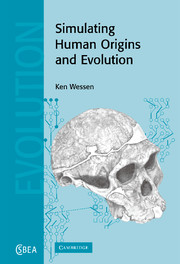8 - Overview
Published online by Cambridge University Press: 14 August 2009
Summary
In the first part of this book, simulations designed to generate a tree of related but separate species were studied. The primary concern was the reconstruction of phylogenies from the simulated fossils, and how the accuracy of the reconstructions was affected by factors such as the rate of fossilisation, non-hereditary adaptation and migrations. The discrete species generations represented time steps ranging from a few hundred thousand years to one million years, and the simulation resolution was, at finest, subspecies or large interbreeding groups. In this second part, the simulation units are individuals and the time steps single, non-overlapping generations. Thus genealogies, rather than phylogenies, are simulated. In order to allow for a fine and detailed analysis of the role of various parameters of interest, e.g. sex ratio and breeding patterns, varying and structured populations, these simulations must involve much larger populations and many more generations than in the species case.
Neutral models permit the separation of demographic effects from mutation (Kimura, 1968); because demographic effects, such as those mentioned above, are the primary focus of the simulations, introduction of the genetics models is delayed until Chapter 12 and the reconstruction of genealogies is assumed to be perfect. Incorporating selection substantially increases the complexity of any analysis, precisely because such a separation is not possible (Hudson, 1990; Tavaré et al., 1997).
- Type
- Chapter
- Information
- Simulating Human Origins and Evolution , pp. 133 - 150Publisher: Cambridge University PressPrint publication year: 2005



